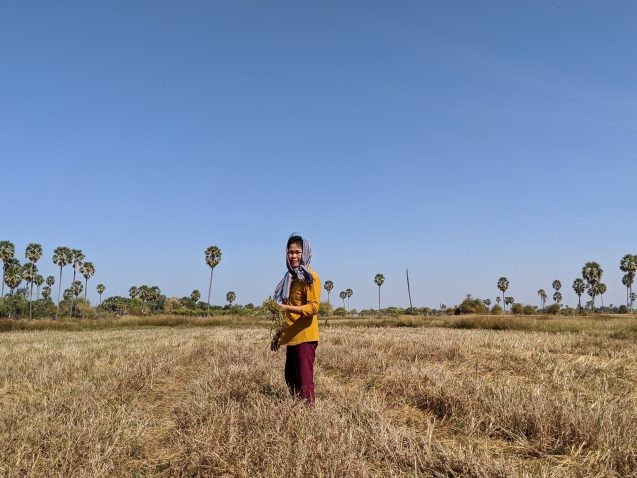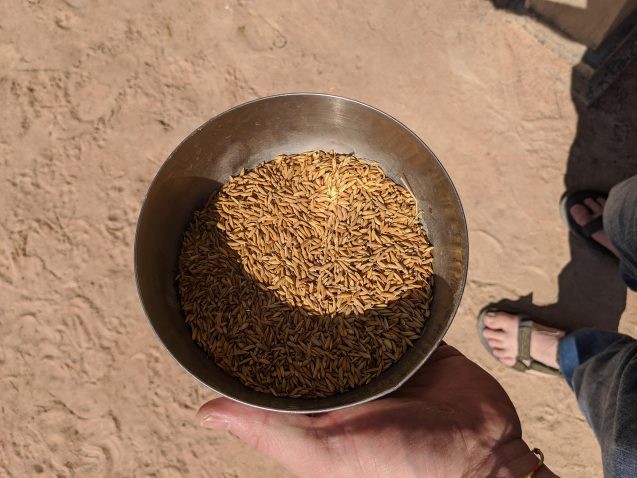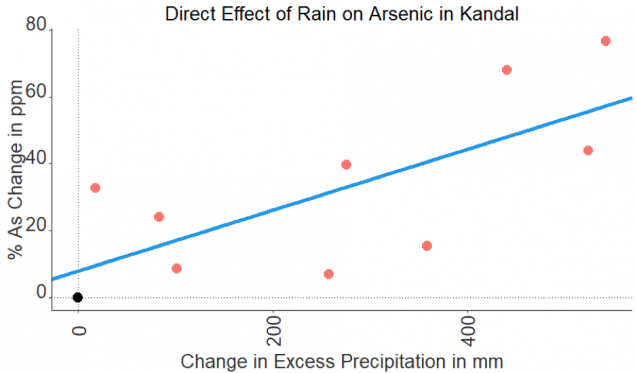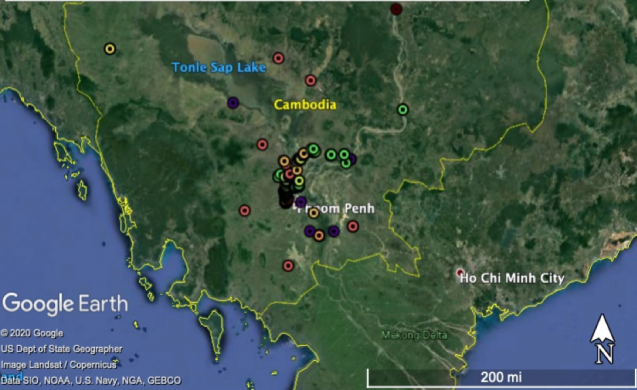Interns Find Links Between Climate and Arsenic Levels in Rice
The research, from students working with the Center for Climate and Life, also identifies ways to potentially limit arsenic contamination in rice.
By Harrison Gerson, Daniel Shneider, Patryk Dabek, Mia Dominguez, Alexander Raftopoulos, Brian Zhang and Benjamin Bostick

Rice makes up 20 percent of caloric intake worldwide. Although this staple crop is inexpensive and filling, rice tends to contain large amounts of arsenic. The greatest problem is in Southeast Asia, especially Cambodia, where rice can make up more than 70 percent of the calories in typical diets. Many Cambodians live in regions that are affected by high arsenic levels in drinking water, exposure to which is linked to cardiovascular disease, cancer and other deadly diseases. Recent evidence suggests rice also is a significant source of arsenic to humans, particularly for people who consume large quantities of rice. Rice often contains arsenic because the biochemical processes associated with the annual flooding of rice paddies (soils where rice is grown) produce dissolved arsenic that is mistakenly incorporated into rice plants as they take in nutrients.
This summer, as interns in the Center for Climate and Life at the Lamont-Doherty Earth Observatory of Columbia University, we have worked to quantify the complex effects of climate on arsenic accumulation in rice. The idea is simple: Climate affects flooding and biological processes in flooded soils, and thus can affect the chemical cycling of arsenic in soils and its uptake into rice. However, it is not straightforward to test our thesis because there are many other factors that can impact rice arsenic levels. For example, agricultural systems are constantly affected by farming practices such as irrigation, choice of rice variety and fertilizer use, most of which are not reported in studies measuring arsenic in rice. The information we obtain will help understand the processes that regulate arsenic levels, but our main goal is to use that knowledge to educate farmers and policymakers about adaptations that would help make rice production more sustainable and healthier into the future. Hopefully, our presented research will also raise awareness about the effects of arsenic in rice, and empower people to address this problem from the roots up (pun intended).

Our first discussions revolved around the processes that affect arsenic releases from soils into water in the soil’s pores, the necessary step in getting arsenic into rice. It was possible to identify two climate variables where data are readily available: the amount of water (which controls how much oxygen is in the system, which determines how much arsenic is released from the soil), and temperature (which affects the rates of the reactions that release arsenic). Next, we established that there are distinct kinds of variation in temperature and precipitation: short-term changes on daily, monthly, or seasonal scales, and long-term changes over decades or longer. Short-term climate variation includes monsoonal or other seasonal-scale changes in climate, while long-term climate variability reflects gradual changes and trends such as sustained droughts, or the effects of anthropogenic climate change.
To examine the relationship between arsenic levels in Cambodia and long- and short-term effects of climate variance, we linked remotely sensed climate data from specific years to rice yield and arsenic levels.
Our data indicates that increases in seasonal monsoonal rainfall in Cambodia lead to direct increases in mean arsenic concentrations in rice grown during that season. Determining this relationship was not easy during the COVID-19 pandemic. We had to depend on rice arsenic concentrations reported in the literature, and a variety of climate records of widely variable density and quality. Most research papers to date have focused on single field locations for detailed investigations that do not report growing season, or compared samples between locations with little or no attention given to the effects of growing conditions on that arsenic level. As a result, those studies are difficult to incorporate into a larger dataset that includes relevant climate data, which could be a significant source of variation between areas or years. Our study synthesized data reporting rice arsenic levels for rice produced in the 2008, 2010, 2012, 2017, and 2018 climate years, over which rainfall varied considerably. By comparing yearly levels of arsenic and rainfall changes, the direct relationship we found is more reliable.

How Climate Affects Arsenic in Rice
To understand why climate change has such a consequential impact on arsenic in rice, we had to first understand the relationship between the climate and the microbes present in soil. Fundamentally, the microbial community is interconnected with its environment. As conditions change, so do the metabolic processes of the microbes. Water covering the soil critically slows the delivery of oxygen into the soil and causes conditions to become anaerobic (also called anoxic). Notably, under anoxic conditions, microbes utilize arsenic as terminal electron acceptors. As the microbes reduce (add electrons to) iron oxides (rust) where arsenic typically attaches, it changes to reduced and soluble iron. At the same time, arsenate (As+5) is reduced to arsenite (As+3). Both iron and arsenic reduction cause As to enter the soil solution, where it can be taken up by plants or contaminate drinking water.
Principally, changes in precipitation due to climate change influence flooding and drought cycles, which greatly affect the reduction of iron and arsenic by the microbes. Climate change also influences temperature, which can affect the rates of biological or chemical processes, and the concentrations of bioavailable organic matter needed for those microbes to thrive. In particular, soluble organic matter (SOM) plays many important roles. Most importantly, it takes part in the metabolic process that reduces iron and arsenic, making it bioavailable for uptake in rice. Changes in temperature are important because they affect the rates of organic matter production, and its decomposition. As temperature increases, reactive SOM concentrations increase in the rice patties, causing more reduction. Oscillations in conditions also can affect SOM availability. Frequent oscillations between flooded and dry conditions, which are the norm for rice production, deplete SOM and decrease arsenic mobility, lowering arsenic in rice.
Potential Pathways for Managing Arsenic Levels
The data suggested that both rice yield and arsenic levels were impacted primarily by short-term climate variation. These short-term (annual) changes could be predicted along with predictions of monsoon intensity. In SE Asia, the most significant variable to predict short-term climate variation is the El Niño-Southern Oscillation (ENSO) climate pattern, which affects climate throughout the world. El Niño and La Niña describe weather patterns that are due to temperature fluctuations in surface waters in the equatorial Pacific Ocean. In Cambodia, El Niño years (corresponding to a warm Pacific ocean) tend to be drier, and La Niñas result in less rain. Scientists measure the intensity of an El Niño / La Niña event based on the extent of the temperature anomaly in the equatorial Pacific. We compared their intensity (anomaly) values to rain and discovered a lag of about eight months from the onset of El Niño / La Niña to their maximal effect on local rainfall. Although this relationship is not perfect, it may be possible to use ENSO intensities to predict the following growing year’s rainfall in advance, and thus whether there will be higher or lower arsenic in the rice. This data can advise farmers and policymakers about how to manage rice production in a way that minimizes rice-arsenic levels and maximizes yields. With more research about specific techniques of growing rice, our predictions may be used to efficiently grow rice with low arsenic levels.
Cambodia is a particularly good place to study the effect of climate on rice arsenic, because small-scale farmers still cultivate using traditional methods. Cambodians depend on rice, and grow it with less human manipulation of water, rice variety, and other factors. They depend on local rainfall rather than irrigation and do not often use large quantities of commercial fertilizer in their soil to increase yield. Without these interventions, the chemical conditions controlling arsenic levels in soil and rice are more directly affected by climate and, thus, easier to compare. For the same reasons, agricultural practices can potentially be adapted to prevent high arsenic exposure in rice.
Our results are promising but limited by having few available measurements of rice arsenic levels, most of which are not accompanied by information about the rice variety or growing conditions like fertilizer addition, making it hard to control for their effects. In fact, there was really only enough data available for one small portion of Cambodia near Phnom Penh that indicated harvest date and could be included. To further validate our conclusion, studies examining arsenic levels in rice should be collected yearly under the same conditions and at the same location. Given the harmful effects of arsenic poisoning, we also need to expand our work to cover other regions and countries where rice arsenic has been studied more extensively, such as Bangladesh.

Human interventions, for example adding fertilizer and irrigation water, have played key roles in increasing yields. In Cambodia, rice yields have consistently grown since the 1960s, likely due to increased fertilizer usage (albeit still in small amounts) and an increased use of improved rice varieties (hardier crops with improved nutrient uptake). These and other human practices can potentially also affect arsenic levels in rice. Given the key role of precipitation and flooding in controlling rice arsenic levels, controlling flooding through irrigation and drainage could potentially be an important means of preventing arsenic uptake into rice. Controlling flooding during the growing season also can maximize nutrient availability. Of course, external factors also affect flooding and rice production. Among them, the Mekong river is increasingly regulated by dams. New dams, most constructed far upstream of the floodplain, have decreased flooding and soil nutrient supply. Unfortunately, with this construction, irrigation and fertilizer have become more vital, yet most farmers still do without, and as a result grow less rice and potentially, rice with more arsenic.
As we finalize our research, we want to ensure that rice farmers are educated about the drastic effects of arsenic in their produce. After our research is completed and presented, we hope to create a user-friendly website to share our findings and recommend best practices to minimize arsenic exposure. We will specifically include a section intended just for farmers, including a section translated into Khmer for Cambodians. We hope to create this site with our Cambodian colleagues and partners, many of whom grow rice, to get the results out.

Throughout the project, we greatly increased our understanding of real world data science research. We learned how to use the R programming language, Google Earth, and Excel. Moreover, we strengthened our teamwork and creativity skills, as we all collaborated on the same goal using different methods. Over four weeks, we bridged climate science with various arsenic reports to explain how arsenic in rice changes. We plan to publish our research paper and present our work at the American Geophysical Union Conference in December.
Please stay safe and enjoy your rice!

